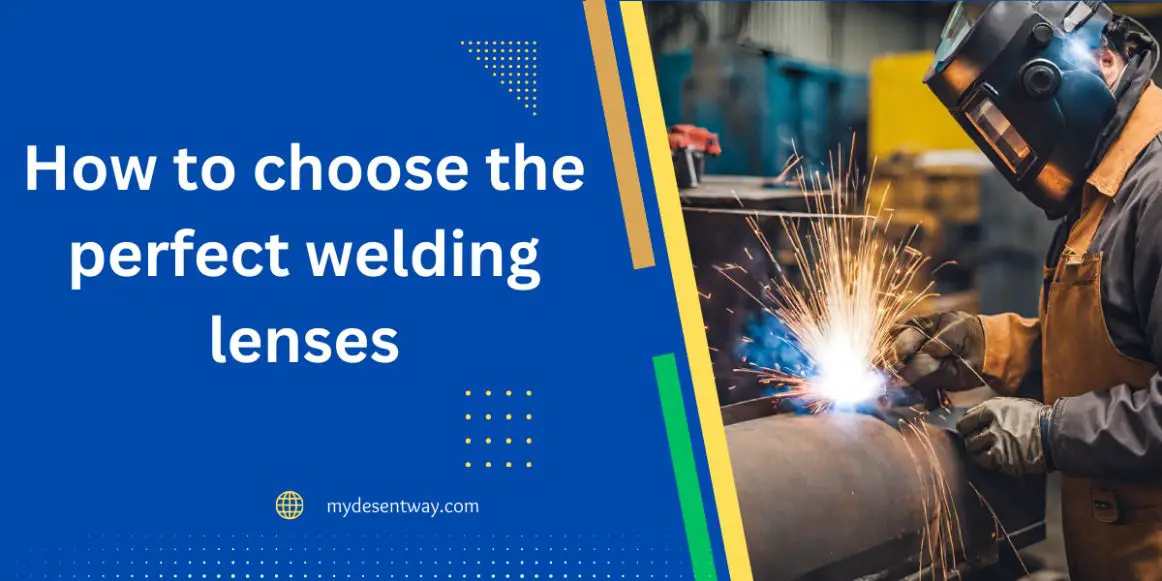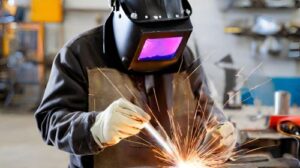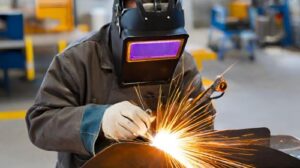Table of Contents
- A Quick Look at Welding Lenses
- 2. The Different Welding Lenses and Their Functions
- 3. Factors to Consider When Choosing a Welding Lens
- 4. Understanding Lens Shade Numbers
- 5. Benefits of Auto-Darkening Lenses
- 7. Tips for Selecting the Perfect Welding Lens
- 8. Features and Technology in Modern Welding Lenses
- 9. Maintenance and Care for Welding Lenses
- 10. Budget Considerations When Purchasing Welding Lenses
- 11. User-Friendly Guide to Choosing the Perfect Welding Lens
- 12. Customizing Welding Lenses for Personal Preferences
- 13. Future Trends in Welding Lens Technology
- Conclusion
- FAQs
Selecting the right welding lens is a crucial decision that impacts safety, efficiency, and precision in welding. Understanding the diverse range of lenses, their features, and the factors influencing their choice is pivotal.
In this comprehensive guide, we explore the nuances of welding lenses, offering insights, tips, and future trends to empower welders to make informed decisions. Dive in to discover how choosing the perfect welding lens can elevate your safety, comfort, and overall welding experience.
A Quick Look at Welding Lenses
Welding, an integral part of various industries, demands precision and safety measures to ensure both efficient work and the well-being of welders. One critical component contributing to safety during welding processes is the welding lens.
Welding lenses serve as a protective barrier between the intense light generated during welding and the welder’s eyes, safeguarding them from harmful radiation, sparks, and debris.
Significance of Welding Lenses
The importance of welding lenses cannot be overstated. These lenses not only shield the eyes from ultraviolet (UV) and infrared (IR) radiation emitted during welding but also aid in maintaining visibility and clarity during the process.
They come in various types, each with its own set of benefits and considerations, providing welders with options to suit different preferences and working conditions.
Overview of Lens Types
The two primary types of welding lenses are Passive Lenses and Auto-Darkening Lenses.
1. Passive Lenses: Traditional in their design, passive lenses have a fixed shade that doesn’t change when exposed to light. They offer reliable protection but necessitate the welder to lift their helmet to inspect the work area between welding tasks.
2. Auto-Darkening Lenses: These lenses have become increasingly popular due to their innovative technology. They automatically adjust the shade level in response to the intensity of the welding arc. Auto-darkening lenses enable welders to maintain visibility before and after welding without the need to raise the helmet continually.
Importance of Choosing the Right Lens
Selecting the appropriate welding lens is crucial for the safety and efficiency of the welding process. Factors such as the type of welding, materials being welded, comfort, and visibility play pivotal roles in determining the ideal lens choice.
An improperly chosen lens can result in eye strain, reduced visibility, and, in severe cases, eye damage due to prolonged exposure to hazardous light emissions.
Purpose of the Article
This article aims to delve into the intricate details of welding lenses, offering comprehensive guidance on the selection, understanding, and maintenance of these critical components.
By exploring different types, factors influencing choice, understanding shade numbers, and future trends, this guide endeavors to equip welders with the necessary knowledge to make informed decisions regarding their welding lens selection.
2. The Different Welding Lenses and Their Functions
Welding lenses are not one-size-fits-all they come in various types, each offering distinct advantages and considerations for welders. Understanding the differences between Passive Lenses and Auto-Darkening Lenses can significantly impact the welding experience.
Passive Lenses
Overview: Passive lenses are the traditional lenses used in welding helmets. They are crafted with a fixed shade that remains constant regardless of the welding conditions. Typically, these lenses have a darker shade, providing protection against intense light emitted during welding processes.
Advantages:
- Reliability: Passive lenses have a simple, robust design without any electronic components, making them reliable and durable.
- Cost-Effectiveness: They are often more affordable than their auto-darkening counterparts, appealing to welders on a budget.
Considerations:
- Limited Visibility: As the shade doesn’t adapt, welders need to frequently lift their helmets to assess their work, disrupting workflow and potentially causing neck strain.
- Adjustment Challenges: Switching between tasks requiring different levels of brightness might necessitate changing the entire helmet, causing workflow interruptions.
Auto-Darkening Lenses
Overview: Auto-darkening lenses have revolutionized welding safety and efficiency. These lenses employ advanced technology that automatically adjusts the shade level in response to the intensity of the welding arc.
Advantages:
- Enhanced Visibility: These lenses offer constant visibility before, during, and after welding without the need to lift the helmet, improving workflow and reducing strain.
- Versatility: Auto-darkening lenses allow welders to work with various welding processes and material thicknesses without the need for manual adjustments.
Considerations:
- Cost: They are generally more expensive due to their sophisticated technology and electronic components.
- Battery Dependency: Some auto-darkening lenses are battery-powered, requiring periodic replacements or recharging.
Choosing the Right Lens
The selection between passive and auto-darkening lenses depends on individual preferences, budget constraints, and the nature of welding tasks. While passive lenses remain reliable and cost-effective, auto-darkening lenses offer unparalleled convenience and continuous visibility, especially in dynamic work environments.
3. Factors to Consider When Choosing a Welding Lens
Selecting the right welding lens involves a thoughtful consideration of several key factors that directly impact both safety and work quality. Understanding these elements aids welders in making informed decisions tailored to their specific needs and working conditions.
1. Lens Shade Number
Significance: The shade number denotes the darkness of the lens and its ability to filter light. Lower shade numbers are suitable for less intense welding, while higher shades are necessary for more substantial welding operations.
Considerations:
- Welding Process and Material Thickness: Different welding processes and thicker materials require higher shade numbers to shield against increased light intensity.
- Optimal Visibility: Balancing shade and darkness is crucial to ensuring clear visibility of the welding area without exposing the eyes to harmful radiation.
2. Lens Material and Durability
Materials:
- Polycarbonate: Lightweight and impact-resistant, commonly used in welding lenses for durability and protection against debris.
- Glass: Offers exceptional optical clarity but might be less impact-resistant compared to polycarbonate.
Considerations:
- Resistance to Impact and Heat: Welding environments often involve flying debris and extreme temperatures, necessitating lenses capable of withstanding these conditions.
- Longevity: Choosing a lens material that maintains optical clarity over time is vital to ensure consistent visibility and safety.
3. Optical Clarity and Viewing Size
Clarity:
- Distortion: Ensure the lens provides a clear, undistorted view of the welding area to prevent errors in workmanship.
- Color Recognition: Opt for lenses that maintain accurate color recognition to identify weld joints and materials accurately.
Viewing Size:
- Larger Viewing Area: Enhances visibility and improves work precision by providing a broader field of vision.
- Comfort: Larger viewing areas can contribute to a more comfortable welding experience, reducing eye strain.
4. Sensitivity and Reaction Time
Sensitivity Settings:
- Adjustability: Ability to customize sensitivity settings ensures the lens responds accurately to changes in light intensity.
- Delay Adjustments: Controlling the delay in transitioning from dark to light allows welders to maintain visibility when the welding arc stops.
5. Comfort and Fit
Helmet Design:
- Weight and Balance: A well-balanced helmet reduces strain on the neck and ensures comfort during prolonged use.
- Headgear Adjustability: Customizable headgear ensures a snug fit for various head shapes and sizes, enhancing comfort and safety.
4. Understanding Lens Shade Numbers
The shade number of a welding lens serves as a crucial determinant of the level of protection and visibility it offers during welding operations. Delving into the nuances of these shade numbers aids welders in selecting the most appropriate lens for their specific welding applications.
Explanation of Lens Shades
Range: Lens shades typically range from 3 to 13, with lower numbers indicating lighter shades and higher numbers representing darker shades.
Shade Levels:
- Shade 3 to 8: Suitable for lower-intensity welding processes such as TIG welding, providing adequate protection while allowing better visibility of the work area.
- Shade 9 to 13: Designed for higher-intensity welding like MIG or stick welding, offering increased protection against intense light but reducing visibility due to their darker nature.
Relation to Welding Applications
Welding Processes and Recommended Shades:
- TIG Welding: Generally requires shades between 7 to 9, balancing visibility and protection against the moderate intensity of the arc.
- MIG and Stick Welding: Demand higher shade numbers (10 to 13) due to the heightened light emissions, ensuring optimal eye protection.
Other Factors Influencing Shade Selection:
- Amperage Levels: Higher amperage levels might necessitate darker shades to mitigate the increased light intensity.
- Work Environment: Factors like ambient light and reflective surfaces might influence the choice of shade number for optimal visibility and eye protection.
5. Benefits of Auto-Darkening Lenses
Auto-darkening lenses have revolutionized the welding industry, offering numerous advantages over traditional passive lenses. Understanding these benefits helps welders appreciate the significant improvements in safety, efficiency, and overall work quality.
Advantages over Passive Lenses
Continuous Visibility:
- Pre, During, and Post-Welding: Auto-darkening lenses allow welders to maintain visibility without needing to raise their helmets, enhancing workflow efficiency.
- Reduced Eye Strain: Continuous visibility minimizes eye strain caused by frequent lifting and lowering of the helmet.
Adaptability and Versatility:
- Automatic Adjustment: These lenses automatically adapt to changes in light intensity, ensuring consistent eye protection across various welding processes and material thicknesses.
- Saves Time: Eliminates the need for manual adjustment, saving time and enhancing productivity.
Improved Safety and Accuracy:
- Immediate Protection: Instant darkening upon exposure to the welding arc provides immediate eye protection, reducing the risk of eye injuries caused by delayed reactions.
- Precision and Control: Allows for precise control over the shade level and sensitivity settings, optimizing visibility and safety.
Enhanced Workflow and Comfort
Seamless Transition:
- Seamless Switching: Auto-darkening lenses swiftly adjust between shades, allowing welders to seamlessly transition between different welding tasks without interruptions.
- Comfortable Working Experience: The continuous visibility and adaptability contribute to a more comfortable and focused working environment.
Improved Quality of Work:
- Enhanced Precision: Clear and uninterrupted visibility enhances accuracy and precision in weld placement, leading to higher-quality welds.
- Reduced Rework: Improved visibility reduces errors, minimizing the need for rework and enhancing overall work quality.
7. Tips for Selecting the Perfect Welding Lens
Choosing the ideal welding lens involves considering various factors that impact safety, comfort, and efficiency during welding tasks. These tips aim to guide welders in making informed decisions when selecting the most suitable lens for their specific needs.
1. Try Before You Buy
Test comfort and visibility:
- Wearability: Try different helmets with lenses to assess comfort, weight distribution, and headgear adjustability for a snug fit.
- Visibility Assessment: Ensure the lens provides clear, undistorted visibility of the welding area.
2. Check for Certifications and Standards
Compliance with Safety Standards:
- ANSI/ISEA and CE Ratings: Look for lenses complying with these standards to ensure adequate protection against optical radiation and impact resistance.
- Reliability: Opt for lenses from reputable manufacturers with proven safety certifications.
3. Consider Your Specific Needs
Welding Processes and Intensity:
- Match Shade Numbers: Align the lens shade number with the specific welding processes and amperage levels to ensure optimal eye protection without compromising visibility.
- Adaptability: Consider lenses that accommodate the various welding techniques you frequently employ.
4. Evaluate the Welding Environment
Environmental Factors:
- Ambient Light Conditions: Assess the lighting conditions in your work environment to select a lens that offers the best visibility and eye protection.
- Reflective Surfaces: Consider lenses that mitigate glare from reflective surfaces, enhancing visibility.
8. Features and Technology in Modern Welding Lenses
The evolution of welding technology has brought forth a range of innovative features in modern welding lenses, enhancing safety, convenience, and overall performance. Understanding these advancements helps welders make informed decisions when selecting lenses.
Advanced Features in Auto-Darkening Lenses
Variable Shade Control:
- Customizable Shades: Allows welders to adjust the shade level according to the specific welding process, material thickness, and ambient light conditions.
- Variable Sensitivity and Delay: Enables precise control over how quickly the lens switches from light to dark and vice versa.
Grind Mode:
- Convenience: Grind mode permits welders to use the helmet as eye protection during grinding tasks without the need to remove the helmet or switch lenses.
- Optimized Visibility: Provides a clear view in light conditions while maintaining eye protection.
Innovative Technologies Enhancing Safety and Performance
Optical Clarity Enhancement:
- True Color Technology: Offers a more natural color perception, enhancing visibility and reducing eye strain.
- High-Definition Optics: Provides distortion-free views, allowing for precise weld placements and better overall work quality.
Helmet Design Improvements:
- Lightweight Materials: The integration of lightweight yet durable materials in helmet construction reduces fatigue during prolonged use.
- Comfort Enhancements: Padded headgear and ergonomically designed helmets contribute to improved comfort and prolonged wearability.
9. Maintenance and Care for Welding Lenses
Proper maintenance and care of welding lenses are crucial to ensure their longevity, optimal performance, and, most importantly, the protection they provide to the welder’s eyes. Implementing appropriate care routines can significantly extend the lifespan of these critical safety components.
Cleaning and Storage Recommendations
Cleaning Procedures:
- Use Proper Cleaning Materials: Soft, lint-free cloths and lens cleaning solutions specifically designed for welding lenses.
- Gentle Cleaning: Avoid abrasive materials or harsh chemicals that could scratch or damage the lens surface.
Storage Practices:
- Protective Cases: Store lenses in dedicated, protective cases when not in use to shield them from dust, debris, and potential impacts.
- Avoid Direct Sunlight: Store lenses away from direct sunlight or extreme temperatures to prevent damage or distortion.
Extending the Lifespan of Lenses
Regular Inspection:
- Check for Damage: Periodically inspect lenses for any signs of damage, scratches, or cracks that could compromise their effectiveness.
- Replace damaged lenses: Promptly replace damaged lenses to maintain adequate eye protection.
Proper Handling:
- Avoid Dropping: Handle lenses with care to prevent accidental drops or impacts that could impair their functionality.
- Follow Manufacturer Recommendations: Adhere to manufacturer guidelines for handling and care to ensure the longevity of the lenses.
10. Budget Considerations When Purchasing Welding Lenses
Selecting welding lenses involves balancing cost and quality to find a suitable option that meets both budget constraints and safety requirements. Understanding how to navigate budget considerations helps welders make informed purchasing decisions without compromising on essential features.
Finding a Balance Between Cost and Quality
Assessing Essential Features:
- Identify Must-Have Features: Determine essential features necessary for safety and efficient welding operations.
- Evaluate Additional Features: Consider whether advanced features justify the higher cost or if basic functionalities suffice.
Value for Money Options:
- Comparative Analysis: Compare various brands and models to find lenses offering the best combination of essential features and affordability.
- Consider Long-Term Benefits: Assess the long-term value and durability of lenses compared to their initial cost.
Factors Influencing Budget Considerations
Brand and Technology:
- Brand Reputation: Certain brands offer advanced technologies and reliability at higher costs, while others provide more budget-friendly options.
- Essential vs. Advanced Features: Determine if advanced features are crucial for specific welding tasks or if basic features suffice.
Long-Term Cost Analysis:
- Durability and Lifespan: Consider the longevity of lenses and potential savings from durable, long-lasting options.
- Maintenance Costs: Evaluate maintenance requirements and associated costs for different lens options.
Value-Oriented Decision-Making
Prioritizing Safety and Essential Features:
- Non-Negotiables: Ensure essential safety features and quality standards are not compromised for cost-saving purposes.
- Finding Affordable Alternatives: Explore budget-friendly brands or models that meet safety requirements without unnecessary additional costs.
11. User-Friendly Guide to Choosing the Perfect Welding Lens
Selecting the ideal welding lens involves a systematic approach to ensure a seamless and informed decision-making process. This user-friendly guide outlines a step-by-step method and essential tips for welders, especially beginners, to choose the perfect welding lens.
Step-by-Step Selection Process
Step 1: Assess Welding Requirements:
- Welding Processes: Identify the specific welding techniques you frequently use (TIG, MIG, Stick) to determine the suitable shade numbers.
- Material Thickness and Intensity: Consider the thickness of materials and the amperage levels involved in your welding tasks.
Step 2: Understand Lens Features:
- Passive vs. Auto-Darkening: Evaluate the pros and cons of both types to determine which aligns better with your working preferences.
- Advanced Features: Familiarize yourself with advanced features like variable shade control, grind mode, and optical clarity enhancement.
Step 3: Budget Evaluation:
- Essential vs. Advanced Features: Assess which features are essential for safety and performance and if advanced features fit within your budget.
Tips for Beginners
Seek Expert Advice:
- Consult Peers or Experts: Seek advice from experienced welders or instructors to understand lens requirements for various welding scenarios.
- Online Resources and Reviews: Utilize online forums, reviews, and resources to gather insights and recommendations.
Test Before Purchase:
- Try Before You Buy: If possible, test different lenses to assess comfort, visibility, and usability before making a purchase decision.
Testing and Assessing a Welding Lens
Real-World Evaluation:
- Test in Actual Working Conditions: Evaluate the lens performance in your typical working environment to ensure it meets your requirements.
- Assess Comfort and Fit: Ensure the helmet and lens combination is comfortable for prolonged use.
12. Customizing Welding Lenses for Personal Preferences
The ability to personalize welding lenses to individual preferences enhances comfort, usability, and overall satisfaction during welding tasks. Understanding the adjustability features and tailoring options available allows welders to optimize their lenses for a more tailored and efficient experience.
Adjustability Features in Lenses
Variable Shade Control:
- Adaptable Shades: Utilize lenses with adjustable shade settings to customize the darkness level based on specific welding processes and ambient light conditions.
- Enhanced Visibility: Adjust shades to maintain optimal visibility while ensuring adequate eye protection.
Sensitivity and Delay Adjustments:
- Fine-Tuning Settings: Customize sensitivity and delay settings to control how quickly the lens darkens or returns to its normal state, matching individual preferences.
Tailoring Lenses to Individual Needs
Comfort and Fit:
- Headgear Adjustments: Modify headgear settings for a secure and comfortable fit, reducing strain during prolonged use.
- Helmet Design: Select helmets with ergonomic designs that suit personal preferences for weight distribution and balance.
Advanced Technology Integration:
- Advanced Features Utilization: Explore and utilize innovative features like true color technology or high-definition optics to enhance visibility and reduce eye strain.
Ensuring User Satisfaction
Testing and Adjustment:
- Trial and Adjustment Period: Experiment with different settings and features to find the most comfortable and efficient configuration.
- Fine-Tuning Process: Continuously adjust and refine settings based on real-world welding experiences for optimal performance.
13. Future Trends in Welding Lens Technology
The welding industry continuously evolves, embracing technological advancements that enhance safety, efficiency, and user experience. Understanding the future trends in welding lens technology provides insight into the potential advancements that will shape the landscape of welding safety and performance.
Predictions for Advancements
Enhanced Optical Clarity:
- Augmented Reality Integration: Integration of augmented reality (AR) elements into welding helmets for improved visualization and guidance during welding processes.
- Smart Sensors: Implementation of smart sensors for real-time monitoring of environmental conditions and immediate adjustments to lens settings.
Adaptive Technologies:
- AI-Powered Adjustments: Utilization of artificial intelligence (AI) to analyze welding conditions and autonomously adjust lens settings for optimal protection and visibility.
- Dynamic Light Filtering: Development of lenses capable of dynamically filtering light intensity without manual adjustments.
Innovations Shaping the Future
Materials and Durability:
- Advanced Lens Materials: Exploration of new materials with superior durability, impact resistance, and prolonged optical clarity for welding lenses.
- Self-Healing Coatings: Introduction of self-healing coatings to protect lenses from scratches and extend their lifespan.
Integration with Wearable Tech:
- Connectivity and Data Sharing: Integration of welding helmets with wearable tech for data sharing, remote monitoring, and performance analysis.
- Biometric Integration: Incorporation of biometric sensors for enhanced safety and personalized adjustments based on individual physiological responses.
Conclusion
Choosing the right welding lens is a critical aspect of ensuring safety, efficiency, and comfort during welding operations. Throughout this comprehensive guide, we’ve explored various facets of welding lenses, providing insights into their types, factors influencing selection, and future trends in technology.
Key Takeaways:
- Types of Welding Lenses: Understanding the differences between passive and auto-darkening lenses and their suitability for different welding processes.
- Factors to Consider: Exploring crucial factors like lens shade numbers, material, optical clarity, and comfort to make informed choices.
- Benefits and Importance: Recognizing the advantages of auto-darkening lenses, the significance of choosing the right lens, and prioritizing eye protection.
- Tips and Customization: Guidance on selecting lenses, considering budget constraints, customizing for personal preferences, and future trends in lens technology.
Empowerment through Knowledge:
By delving into the nuances of welding lenses, welders gain the knowledge to make informed decisions. From understanding the importance of eye protection to evaluating brands, features, and personalizing lenses, this guide aims to empower welders of all levels with the tools necessary to choose the perfect welding lens for their needs.
Looking Ahead:
As technology advances, the welding industry will witness exciting innovations in lens technology, paving the way for more intuitive, adaptive, and user-centric welding safety gear. Keeping an eye on these future trends will open doors to enhanced safety, efficiency, and user experience.
A Safer and More Efficient Tomorrow:
Ultimately, selecting the perfect welding lens isn’t just about protecting one’s eyes during the job; it’s about ensuring a safer and more efficient welding experience. With the right knowledge and considerations, welders can equip themselves with the best tools, fostering a safer work environment and elevating the quality of their craft.
FAQs
How do I know which shade is suitable for the welding I do?
Different welding processes have recommended shade levels. Consulting guidelines and considering the intensity of the arc helps determine the appropriate shade.
Can I wear prescription glasses under welding lenses?
Yes, certain welding helmets can accommodate prescription glasses. Ensure the helmet comfortably fits over your glasses for adequate protection.
What are some signs that my welding lens needs replacement?
Faded or distorted vision, difficulty in seeing the welding area clearly, or damage to the lens are indications that it’s time for a replacement.
Are more expensive lenses always better?
Not necessarily. Evaluate the features, durability, and suitability for your specific welding tasks to determine the best value for your investment.
How often should I clean my welding lens?
Clean your welding lens regularly, especially if you notice debris or spatter. Aim for cleaning after each use to maintain optical clarity and effectiveness.




2 thoughts on “Welding Lenses: How to Choose the Perfect Lens”